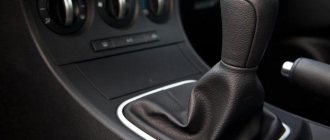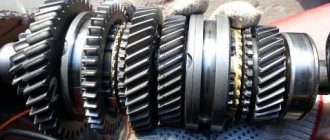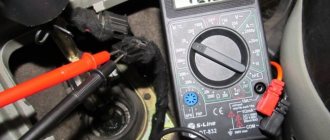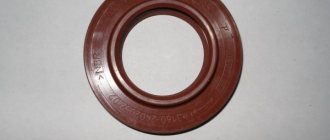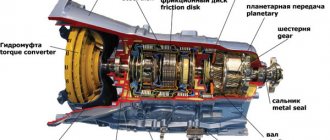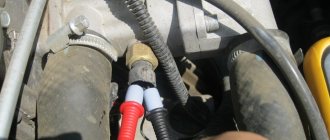- home
- car transmission
- …
As you already understand, we will talk specifically about a manual “box” and about shifting gears (or rather, not shifting) on it. I have quite a lot of experience in this area; I personally repaired cars such as VAZ 2114, VAZ 2110 (and the 10th family in general). To say that there are global differences between foreign cars, there really aren’t any! So if your speed is not cut off, then the reasons may be similar. In general, the article will be useful, at the end, as usual, there is a video...
A fairly large number of such questions come to me, especially from novice drivers of our VAZs! Especially with front-wheel drive, because in rear-wheel drive cars the lever was installed in the manual transmission itself. I want to answer everyone right away - the problem of non-inclusion may not always be cardinal! Often it’s a small matter, something just got loose or unscrewed from time to time, as a rule, this happens in 50% of cases.
Therefore, I will try to break the material into two large components - simple and complex faults.
I suggest starting with simple faults.
What to do if gears do not engage while the engine is running
Sooner or later, any motorist is forced to recognize the appearance of problems in the operation of the gearbox. Mechanical transmissions break down especially often, and the malfunction can occur spontaneously and unexpectedly, but more often than not, gradually, manifesting itself in various uncharacteristic sounds when shifting gears, as well as difficulties in turning them on.
If you cannot move with the engine running, you will have to find out the reason and eliminate it.
Reverse gear does not engage on VAZ 2114: troubleshooting
Sometimes during the operation of the car, motorists are faced with the fact that the reverse gear on the VAZ 2114 does not engage (or it does, but with great effort).
You can diagnose such a breakdown yourself, guided by the signs of wear of certain components presented below:
- When switching, the gear “flies out” and does not lock—wear of the coupling and gear teeth. The solution is to replace worn parts with new ones;
- the gear engages spontaneously - the rubber part of the rear support is worn out or cracked. The solution is to replace the rubber part with a new one;
- When switching to neutral, a loud noise appears - the oil level is very low or it does not meet the requirements (for example, viscosity). The solution is to add/change the oil;
- Reverse engages with a crunch - the synchronizer has worn out. The solution is to replace the synchronizer with a new one (if you continue traveling with a worn synchronizer, you will soon have to replace both the synchronizer itself and the entire gear block);
- When driving in reverse (or any other) gear, noise appears - the lower or upper bearing is worn out. The solution is to replace the bearings (it is advisable to conduct a full diagnosis of the box);
- When driving in any gear, a sharp knock occurs - the drive gear has failed. The solution is to replace the drive gear;
- When changing gears, a cracking noise occurs - the pinion axles are worn out or the locking ring is broken. The solution is to replace worn elements.
In addition to the malfunctions listed above, sometimes others occur, for example, oil leaks. In this situation, it is highly advisable to carry out a full diagnosis of the box, since the reasons for this phenomenon can be very different, and the consequences of untimely repairs can be quite serious.
Common causes of gear shifting problems
There may be many reasons why you cannot move the gearshift lever to the working position. And they are not always associated with a malfunction of the box itself - in some cases the culprit is the clutch, sometimes the engine. In any case, to find out the cause yourself, you must have the appropriate knowledge and experience - otherwise there is a high risk that you will not be able to do this or that as a result of your actions you will have to carry out more complex and expensive repairs.
If the gears do not engage with the engine running due to a malfunction of the gearbox, it will require dismantling and troubleshooting - an operation that requires great care. The same can be said about the clutch. However, it is better to proceed to a more detailed description of possible problems and ways to eliminate them.
Troubleshooting
Many transmission malfunctions that cause the reverse gear to disappear or fall out can be eliminated without removing the unit from the car.
If the cause is a loosening of the bolt securing the clamp on the rod, then to correct the defect it is necessary:
- Place the car on a lift.
- Completely loosen the clamp nut.
- Place the gearshift lever in the fully engaged reverse gear position.
- Fully engage reverse gear at the gearbox using the shift rod on the crankcase.
- Tighten the clamp mounting bolt.
Backstage adjustment
If tightening the clamp does not help get rid of the problem, then you need to check the condition of the shift drive parts. One of the reasons why the reverse gear does not engage may be a poorly adjusted rocker.
To make adjustments to the mechanism, you may need the following tools:
- two wrenches with a size of 13 mm, preferably a socket design;
- any wrench or 10 mm socket;
- small hammer;
- slotted screwdriver.
Since the cause of malfunction of the link can be wear of parts, spare parts may be needed:
- universal joint of the rocker;
- Sometimes the shift rod seal may need to be replaced.
Two people are required to adjust the rocker or replace parts of its drive. One person must change gears from the passenger compartment, and the second must adjust the travel of the shift rods.
The order of work is as follows:
- Provide access to the bottom of the car by placing it on a pit or a lift.
- Using a 13 mm wrench, loosen the clamp installed on the gear shift rod.
- Remove the rod from the box rod.
- Using a screwdriver, carefully remove the boot.
- Using a 10 mm wrench, unscrew the fixing bolt on the cardan shaft.
- Knock off the cardan shaft with light blows of a hammer. It is important not to damage the shaft.
- Remove the universal joint seal boot.
- If there is an oil leak, the sealing gland on the box rod must be replaced.
- Install a new boot (or leave the old one if it is intact) and install the universal joint on the shaft.
- Align the hole on the cardan with the notch on the shaft.
- Tighten the 10 mm clamp and install the boot completely in place.
- Install the rod on the cardan rod and adjust the gearshift lever travel.
- The second person should sit in the driver's seat, set the gear shift lever to neutral, move it slightly to the right and hold it in that position.
- After this, you need to tighten the 13 mm clamp nut.
Typically, after such a repair, the reverse gear starts to engage without problems. In addition, the operation of the entire gear selection mechanism on the VAZ-2109 becomes clearer.
The video from the author MegaMeyhem shows the process of replacing the backstage.
Changing the gearbox oil
If the oil seal on the rod is damaged, oil leaks out of the gearbox housing, and dirt can get into the box itself. These factors may be the reason why reverse gear stops engaging. In addition, the oil in the box loses its properties during operation, so it must be replaced preventively at least once every 35–40 thousand kilometers. Before replacing, you need to check the condition of the oil in the box. To do this, you need to remove the oil dipstick installed in the gearbox housing and visually assess the quality of the oil. The presence of metal and dirt particles in the oil on the dipstick is unacceptable. The oil itself should be quite liquid and not stick to your hands in a thick layer.
Dipstick with oil level marks
We recommend: How and where to fill the brake fluid
To replace, you will need the following materials and tools:
- New oil. When purchasing oil, you need to consider the type of gearbox. For fairly rare four-speed gearboxes, three liters of oil are required, for newer five-speed ones - 3.3 liters. The oil itself must have a tolerance of 80W-85, the manufacturer does not matter.
- A container for draining old oil with a volume of at least 4 liters.
- A funnel with a hose for pouring new oil or a syringe.
- Wrenches 12 and 17 mm of any type.
- Rags and cleaning solvent.
The actual work order is as follows:
- Place the car with the heated gearbox on the pit.
- Remove the rubber plug from the gearbox ventilation valve installed on the top of the crankcase.
- Clean the valve and plug from dust and dirt. It is convenient to clean parts with thin wire and a rag.
- Reinstall clean parts.
- Wipe off dirt from the bottom of the box. Unscrew the plug on the bottom of the box housing.
- Place a container under the drain hole and drain the oil. It will completely merge in at least 20-25 minutes.
- After this, screw the drain plug back into place and carefully tighten it with a wrench. First, the plug and hole must be thoroughly wiped with a rag.
- Pour fresh oil through the oil level dipstick hole in the box.
- During filling, it is necessary to check the oil level, which normally should be between o and “MAX” on the dipstick rod.
- If there is an overflow, the oil can be pumped out with a large medical syringe with a tube on the spout.
- Within a few days after the change, it is advisable to check the level and appearance of the oil. You also need to make sure that there are no leaks through the plug and box seals.
Rubber crankcase ventilation cap Drain hole on the crankcase Dipstick in the upper part of the crankcase An oil funnel installed in the dipstick hole
On early versions of front-wheel drive VAZ gearboxes there is no hole for the dipstick. To fill the oil in the crankcase of such boxes there is a control hole closed with a threaded plug. Filling is carried out using an oil syringe. The oil level is considered normal when it reaches the lower edge of the inspection hole.
The arrow indicates the inspection hole on the side of the gearbox housing. Filling oil with a transmission syringe.
Replacing the gear selection mechanism
One of the common reasons why the reverse gear of a VAZ 2109 does not engage is the breakdown of spring 2 installed in a separate mechanism.
Gear selection mechanism
To access it, it is necessary to remove and repair the mechanism itself, located inside the box.
A short list of necessary actions:
- Disconnect the car.
- Remove the air filter completely.
- Remove the left wheel and loosen the CV joint hub nut.
- Drain the oil from the gearbox crankcase.
- Remove the two bolts securing the left ball joint to the steering knuckle.
- Unlock and remove the steering tip.
- Remove the fist from the CV joint splines.
- Completely remove the left drive.
- Remove the starter and negative wire from the gearbox housing.
- Remove the gear shift rods from the gearbox and clutch.
- Unscrew the speedometer drive cable.
- Place a support under the box housing and remove the box support fastening
- Remove the gearbox from the vehicle and disassemble it.
When disassembling the gearbox, it is necessary to check the condition of the gear locks, since wear is the main reason why the reverse gear spontaneously jumps out of gear. You can get to the lock without removing and disassembling the box; it is located on the side of the crankcase and is closed with a screw plug. Disassembling the gearbox and inspecting the gear selection mechanism will also help solve the problem in which the reverse gear on the VAZ-2109 does not turn off.
We recommend: How to replace the heater radiator on a VAZ 2107
Spring replacement
Often, owners change the entire mechanism assembly, which costs on average about 2 thousand rubles. But you can disassemble the mechanism and get by with replacing the spring, which costs up to 50 rubles.
You need to do the following:
- Remove the stopper from the blocker axle and remove the axle itself.
- Unscrew the lever axle nut.
- Remove the axle and replace the spring.
- Reassemble in reverse order.
Malfunctions when turning on gears and their elimination
The main components of a modern car are characterized by the same operating principles, despite significant differences in their design. In particular, this also applies to manual transmissions (if we do not consider rear-wheel drive cars, in which the lever is connected directly to the transmission).
Front-wheel drive vehicles can have either a longitudinal or transverse gearbox. In the latter case, a link is used for communication between the motor and the gearbox; on some models (for example, on the Ladovsky Vesta and Kalina) a cable drive is used. It is considered simpler and more reliable, but this design is not without its drawbacks and can fail.
So, let's look at the main reasons why gears do not engage when the engine is running.
Traction, drawstring
Since we have already mentioned domestic cars with a transverse power unit (from the “Nine” to the “Priora”), then when the above-mentioned problem appears, it is first necessary to begin the search for the culprits with these mechanisms.
If you notice that when the car starts moving, the gearbox lever rattles chaotically and unpleasantly, most likely it is the rocker that has flown out of its mounting location. This type of malfunction occurs especially often on cars of the Lada Samara family of the first two generations. The solution is to replace the link or fastener element with new ones. We can say that this is the most obvious and easily fixable malfunction of this kind.
Cable
On cars of later years of production, a cable is used instead of a rocker. If this cable breaks, you will not be able to engage the gear, but not only with the engine running, but also with the engine turned off. This is what will indicate that the drive cable is the likely culprit. Replacing it is not difficult, and it is inexpensive compared to other components and parts.
Insufficient transmission oil level
The box, like the engine, may lose its seal, which will lead to lubricant leakage. If there is a deficiency of it, you will feel that the gears are “stuck” with strain, since the engagement of the gears in the absence of oil occurs with great difficulty. If the problem is not corrected in time, the synchronizers will eventually fail and costly repairs will be required.
Therefore, when the first difficulties with switching appear, first check the oil level in the box, and if it is below normal, inspect the transmission for oil stains. If they are detected, you can reduce the amount of work to be done because you will know which gasket or seal needs to be replaced. However, it is recommended to check the integrity of the seals on both sides of the box.
Motor mounting cushion
Many drivers are not aware that due to severely deformed cushions, not only the engine, but also the gearbox will suffer. And this phenomenon is typical for both types of transmissions, manual and automatic.
There are car models on which the boxes are installed on special supports, which must be periodically checked for integrity and, if necessary, replaced. The easiest way to check is to make sure that the engine does not oscillate in the longitudinal direction when idling and increasing speed. If the cushions sag significantly, the motor also lowers, which can lead to breakage of the linkage or jamming of the input shaft rotation. The problem is solved by replacing deformed pillows.
Fork
So far we have considered fairly simple breakdowns that do not require dismantling the gearbox or clutch. It's time to move on to more serious things - clutch problems, due to which the gearbox does not engage while the engine is running.
Second gear slips out on Priora
There were problems with 2nd gear initially, from the moment of purchasing this Lada Priora. Well, how can I say the problem - at first it didn’t turn on at all, then it started turning on with a crunch (we’re talking about a quick start and switching from 1st to 2nd at 6000-6500 rpm, there were no problems during normal driving). I got there :) The second gear began to fly out, and it was impossible to hold it in place even if I held it tightly with my hand - the car jerked violently and did not want to go. I drove almost like in a video recording of one of the blogs of a well-known person - 1-3-5 DAL GONE

